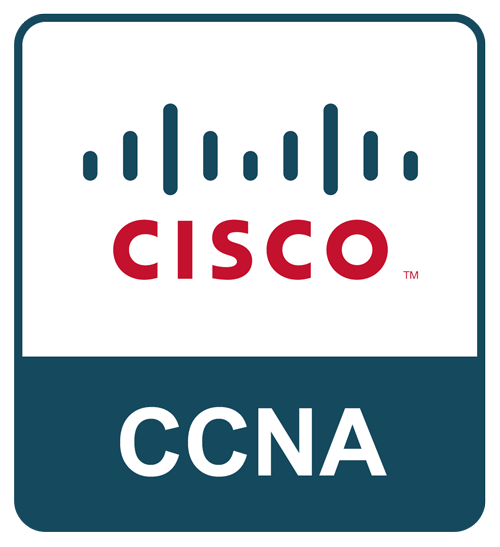CCNA V3
آموزش CCNA بيانگر توانايي شخص در نصب ،پيکر بندي ،پياده سازي و عيب يابي شبکه هايی در مقياس متوسط در زمينه Routing، Switching و شبکه هاي با ارتباطات راه دور که از سرويس هاي مخابراتي استفاده مي کنند مي باشد. سرفصل آموزش CCNA شامل تکنولوژی های مختلف می باشد که در لیست ذیل آورده شده اند:
Networking Concepts:
OSI , TCP/IP Layers , IP classes , Subnetting , VLSM
Licensing
Switching: (Concepts , Intro , Port modes ,Vlan , VTP , PVST+ , Rapid-PVST , Security , EtherChannel , SNMP, SPAN, DHCP, LOG, NTP, HSRP,AAA)
Routing: (Routing Theory , Static Routing ,eBGP , EIGRP , OSPF,IP SLA , Router on a Stick)
Access Control Lists , NAT (Static , Dynamic , PAT)
WAN (HDLC , PPP ,PPOE,GRE,MPLS,DMVPN Wirelee
WAN (3G,4G,LTE)
QOS
SDN
Cloud
computing IPV6 (Static Routing , OSPFV3,EIGRPV6,DHCPV6,NDP,IPV6ACL)
دانشجویان پس از پایان آموزش CCNA توانایی مدیریت شبکه ها در مقیاس متوسط را خواهند داشت . این افراد می توانند سویچ های سیسکو را در این شبکه ها نصب و راه اندازی نمایند. همچنین پروتکل های Routing مختلف جهت برقراری ارتباط ساختمانهای مختلف یک شرکت همچون OSPF، EIGRP eBGP را می توانند راه اندازی نمایند. همچنین این افراد با config کردن NATیا PAT درRouterهای سیسکو ، امکان اتصال کاربران یک شرکت به اینترنت رافراهم سازند. در سالهای اخیر مبحث IPV6 در دنیای IT بسیار مورد توجه قرار گرفته شده است.در این دوره مباحث مقدماتی IPV6 شامل (Static Routing , OSPFV3,EIGRPV6 و ....) مورد بررسی قرار میگیرد. از قابلیت های تخصصی آموزش CCNA می توان به توانایی آنها در پیاده سازی پروتکل های مختلف WAN همچون MPLS, DMVPN, PPP , HDLC و GRE اشاره کرد، از این پروتکل هاجهت اتصال شعبات مختلف یک شرکت توسط Router های سیسکو استفاده می شود. موسسه رایکا تنها موسسه آموزش سیسکو در ایران می باشد که در آن دانشجویان بصورت عملی سناریو CCNA مختلف را با استفاده تجهیزات واقعی ومجازی اجرا می نمایند. دانشجویان پس از گذراندن آموزش CCNA همچنین آشنایی با نمونه آزمون های سیسکو توانایی شرکت در آزمون CCNA را خواهند داشت. اما هدف اصلی رایکا از برگزاری این دوره، توانایی در انجام کار بصورت عملی و اماده سازی دانشجویان برای محیط کار می باشد.
متاسفانه کلاس فعالی فعلا موجود نیست
1.0Operation of IP Data Networks
1.1 Recognize the purpose and functions of various network devices such as routers, switches, bridges and hubs
1.2 Select the components required to meet a given network specification
1.3 Identify common applications and their impact on the network
1.4 Describe the purpose and basic operation of the protocols in the OSI and TCP/IP models
1.5 Predict the data flow between two hosts across a network
1.6 Identify the appropriate media, cables, ports, and connectors to connect Cisco network devices to other network devices and hosts in a LAN
2.0 LAN Switching Technologies
2.1 Determine the technology and media access control method for Ethernet networks
2.2 Identify basic switching concepts and the operation of Cisco switches
2.3 Configure and verify initial switch configuration including remote access management
2.4 Verify network status and switch operation using basic utilities
2.5 Describe how VLANs create logically separate networks and the need for routing between them
2.6 Configure and verify VLANs
2.7 Configure and verify trunking on Cisco switches
2.8 Identify enhanced switching technologies
2.9 Configure and verify PVSTP operation
3.0 IP Addressing (IPv4/IPv6)
3.1 Describe the operation and necessity of using private and public IP addresses for IPv4 addressing
3.2 Identify the appropriate IPv6 addressing scheme to satisfy addressing requirements in a LAN/WAN environment
3.3 Identify the appropriate IPv4 addressing scheme using VLSM and summarization to satisfy addressing requirements in a LAN/WAN environment.
3.4 Describe the technological requirements for running IPv6 in conjunction with IPv4
3.5 Describe IPv6 addresses
4.0 IP Routing Technologies
4.1 Describe basic routing concepts
4.2 Configure and verify utilizing the CLI to set basic Router configuration
4.3 Configure and verify operation status of a device interface
4.4 Verify router configuration and network connectivity using
4.5 Configure and verify routing configuration for a static or default route given specific routing requirements
4.6 Differentiate methods of routing and routing protocols
4.7 Configure and verify OSPF
4.8 Configure and verify interVLAN routing (Router on a stick)
4.9 Configure SVI interfaces
4.10 Manage Cisco IOS Files
4.11 Configure and verify EIGRP (single AS)
5.0 IP Services
5.1 Configure and verify DHCP (IOS Router)
5.2 Describe the types, features, and applications of ACLs
5.3 Configure and verify ACLs in a network environment
5.4 Identify the basic operation of NAT
5.5 Configure and verify NAT for given network requirements
5.6 Configure and verify NTP as a client.
5.7 Recognize High availability (FHRP)
5.8 Configure and verify syslog
5.9 Describe SNMP v2 and v3
6.0 Network Device Security
6.1 Configure and verify network device security features
6.2 Configure and verify Switch Port Security
6.3 Configure and verify ACLs to filter network traffic
6.4 Configure and verify ACLs to limit telnet and SSH access to the router
7.0 Troubleshooting
7.1 Troubleshoot and correct common problems associated with IP addressing and host configurations
7.2 Troubleshoot and resolve VLAN problems
7.3 Troubleshoot and resolve trunking problems on Cisco switches
7.4 Troubleshoot and resolve ACL issues
7.5 Troubleshoot and resolve Layer 1 problems
7.6 Identify and correct common network problems
7.7 Troubleshoot and resolve spanning tree operation issues
7.8 Troubleshoot and resolve routing issues
7.9 Troubleshoot and resolve OSPF problems
7.10 Troubleshoot and resolve EIGRP problems
7.11 Troubleshoot and resolve interVLAN routing problems
7.12 Troubleshoot and resolve WAN implementation issues
7.13 Monitor NetFlow statistics
7.14 TS EtherChannel problems
8.0 WAN Technologies
8.1 Identify different WAN technologies
8.2 Configure and verify a basic WAN serial connection
8.3 Configure and verify a PPP connection between Cisco routers
8.4 Configure and verify Frame Relay on Cisco routers
8.5 Implement and troubleshoot PPPoE


